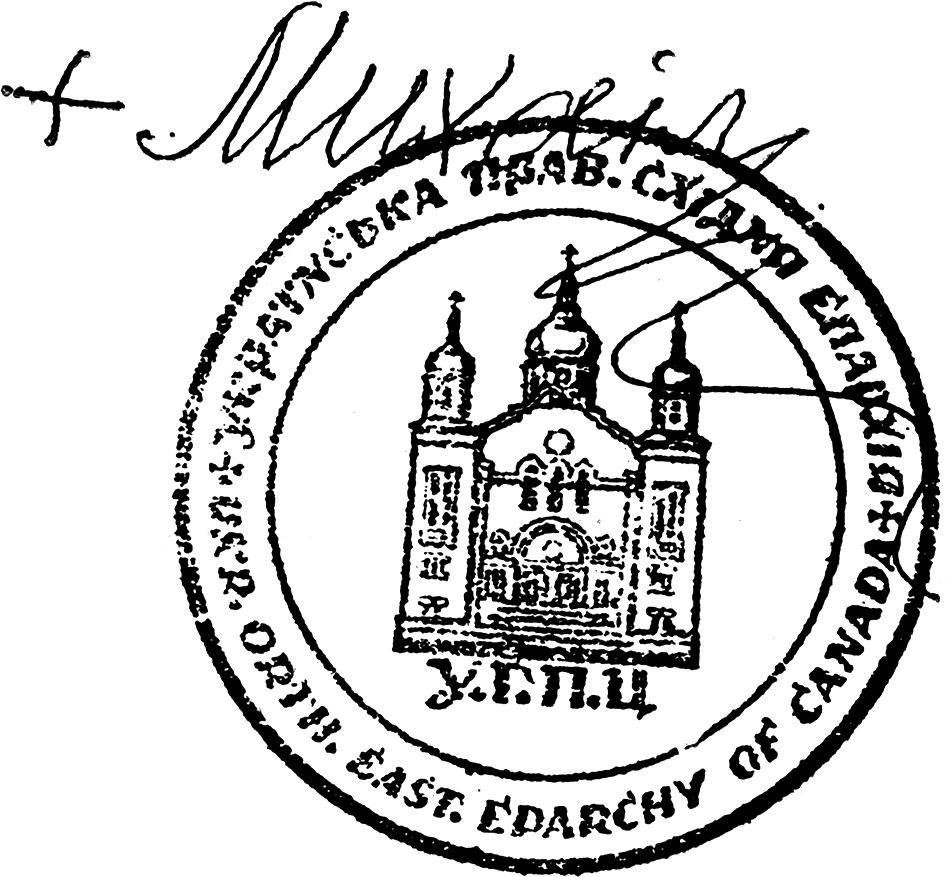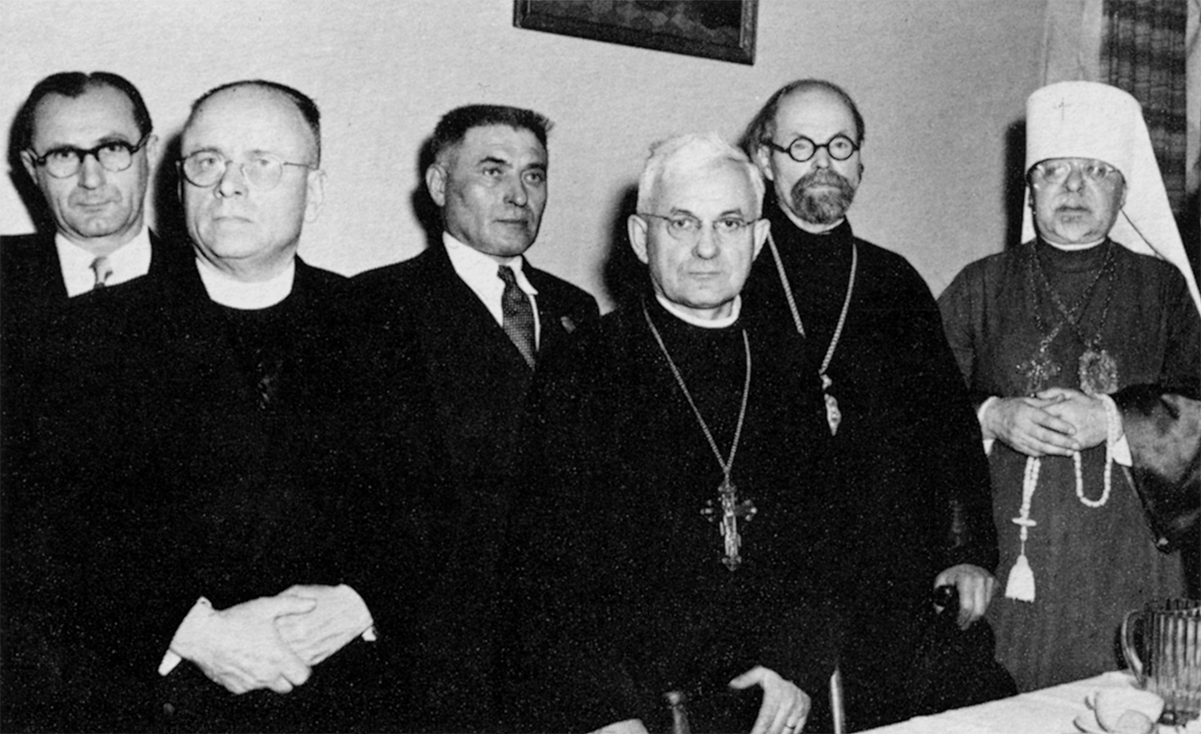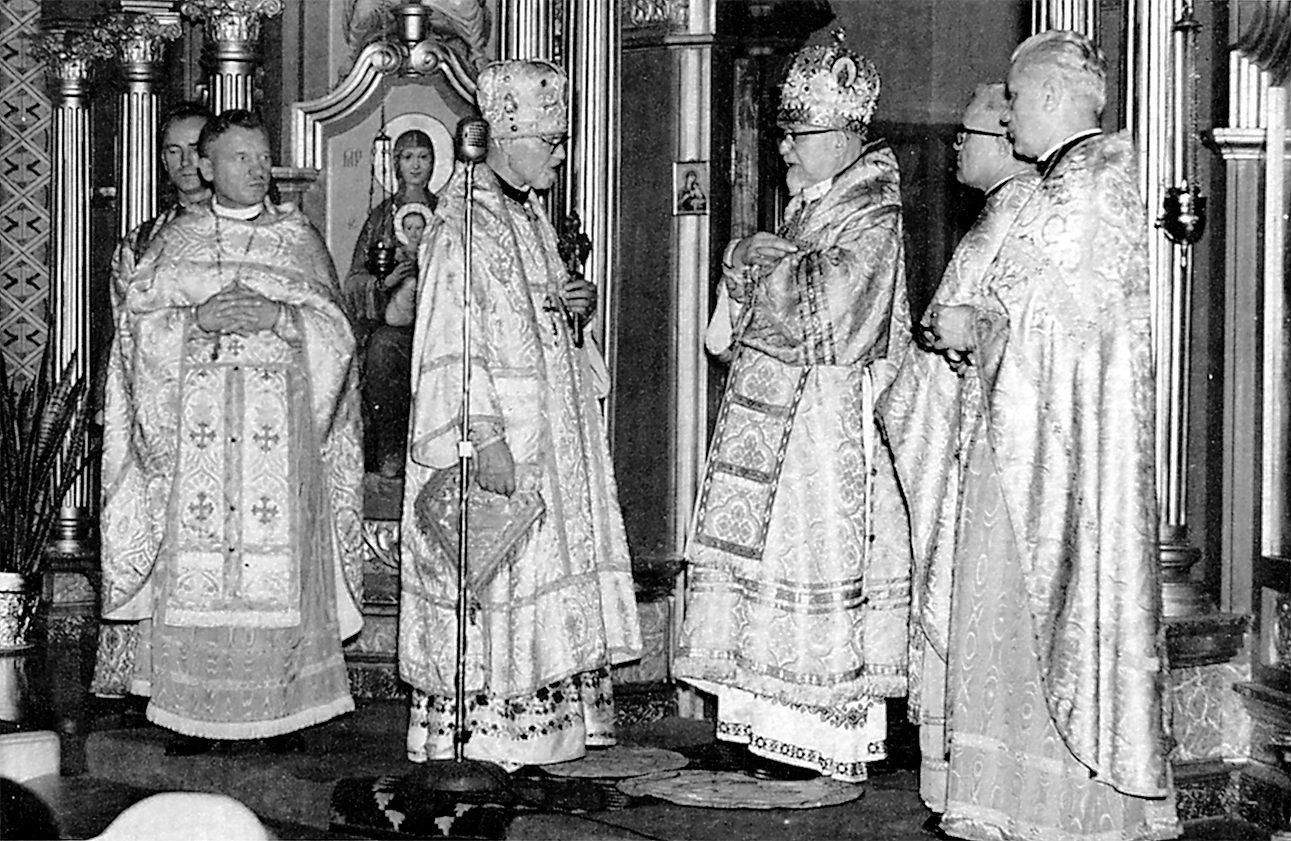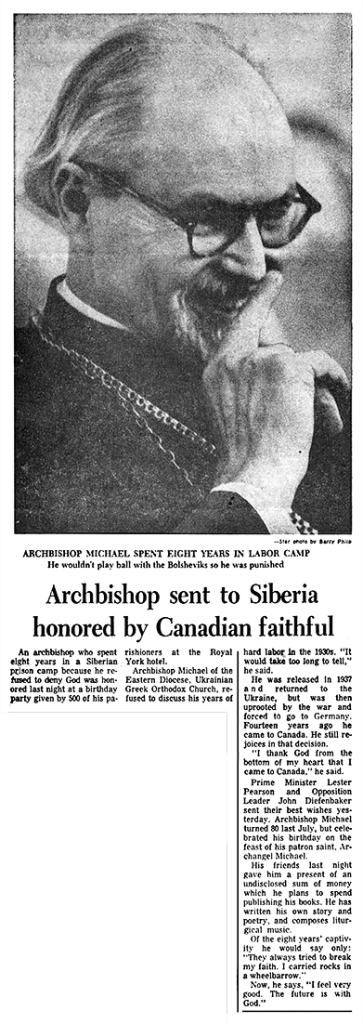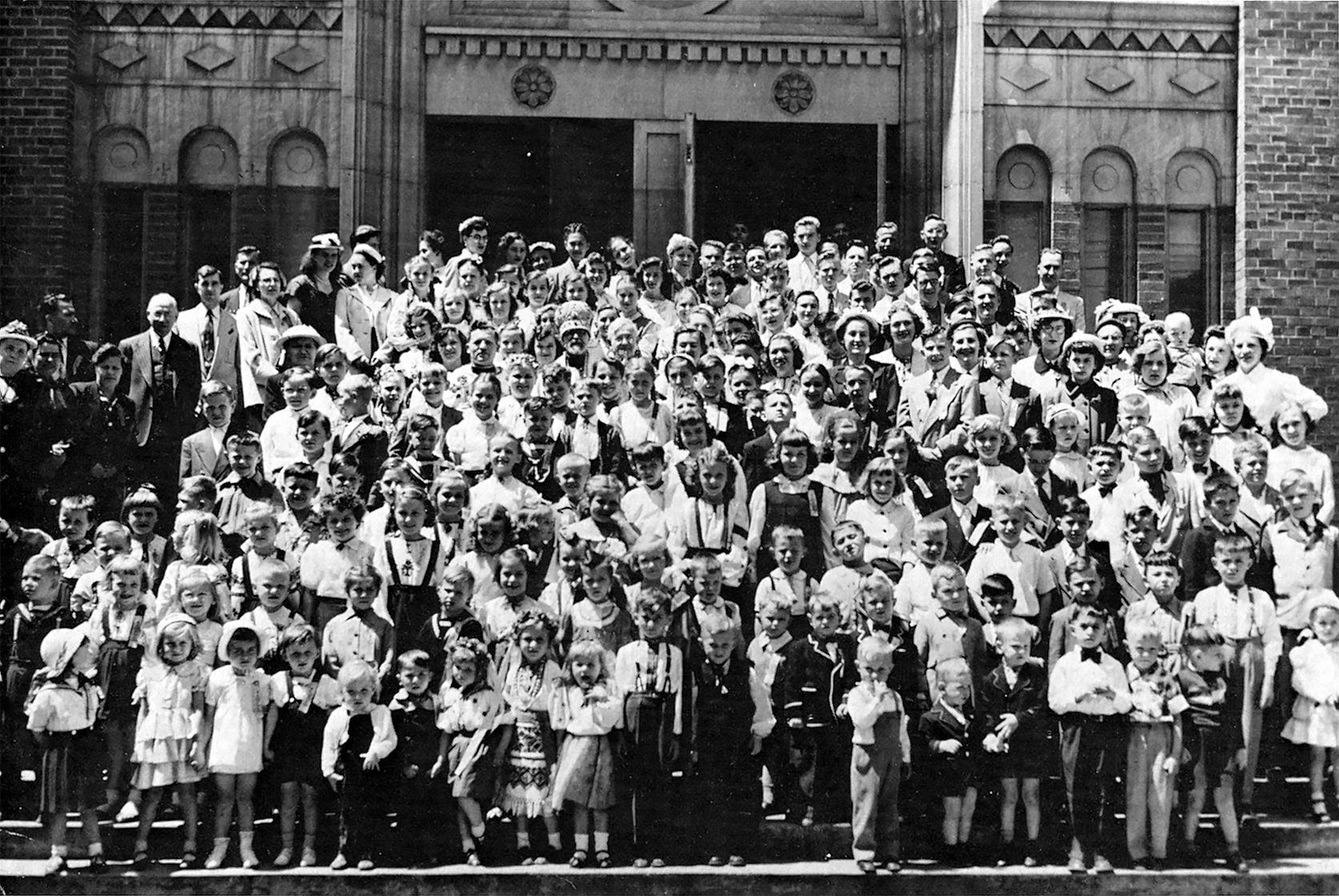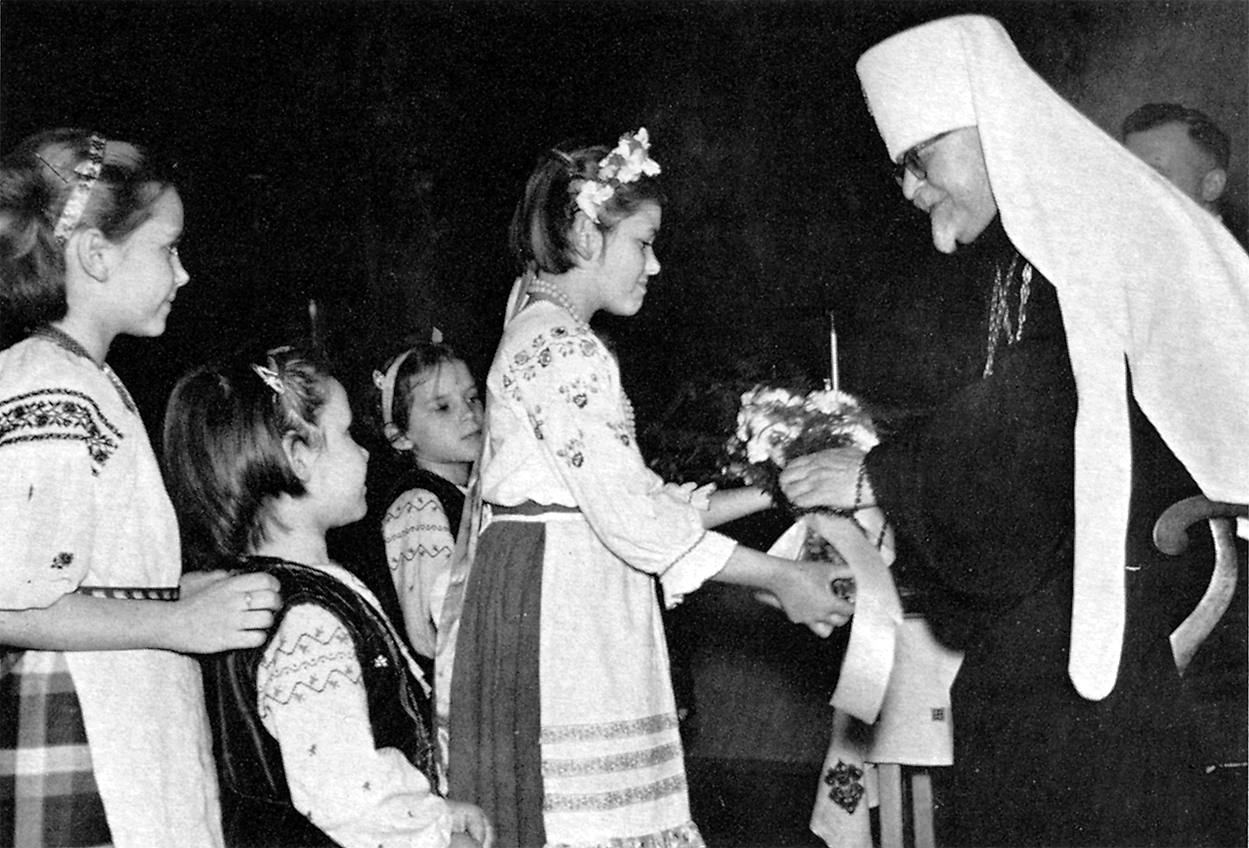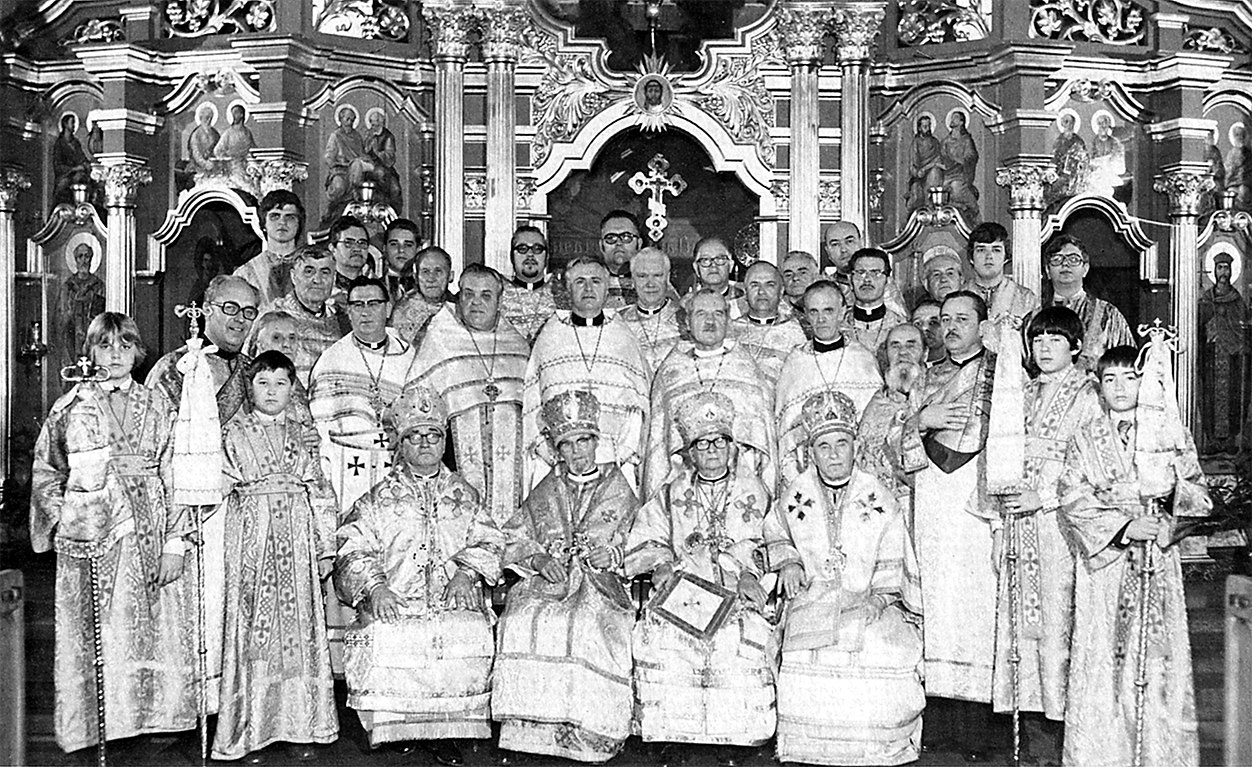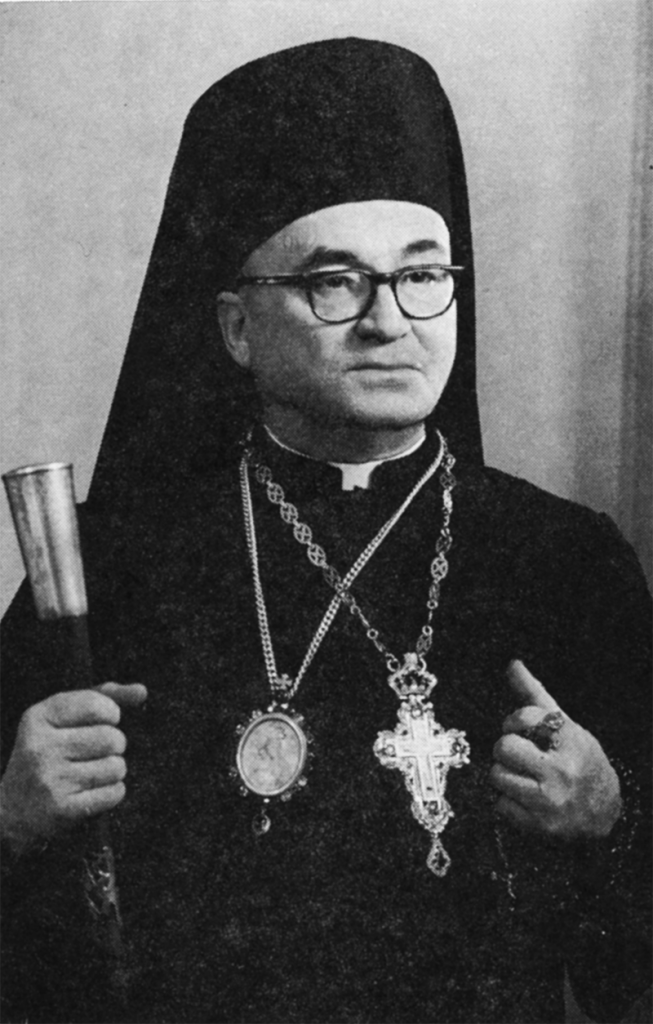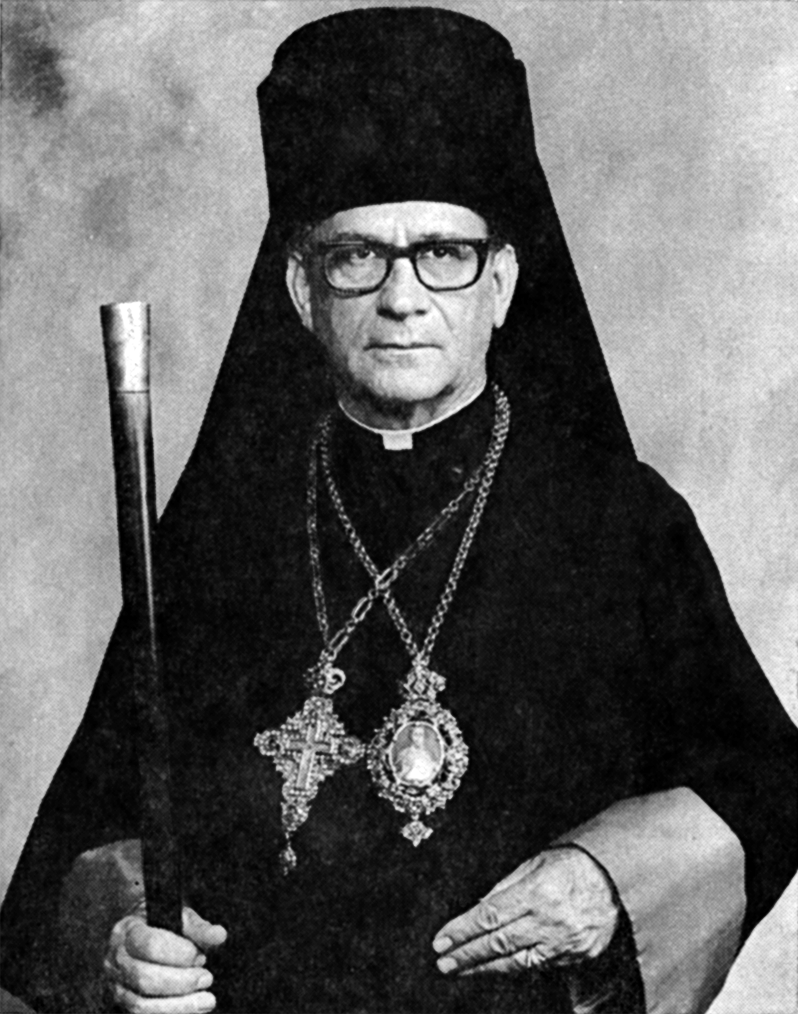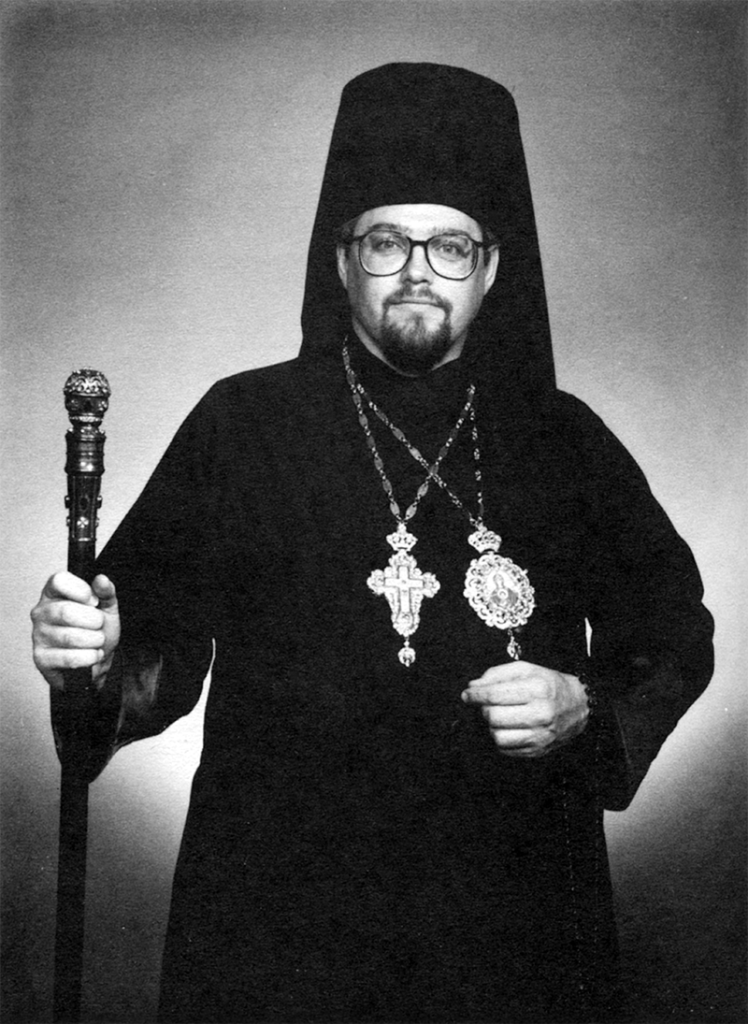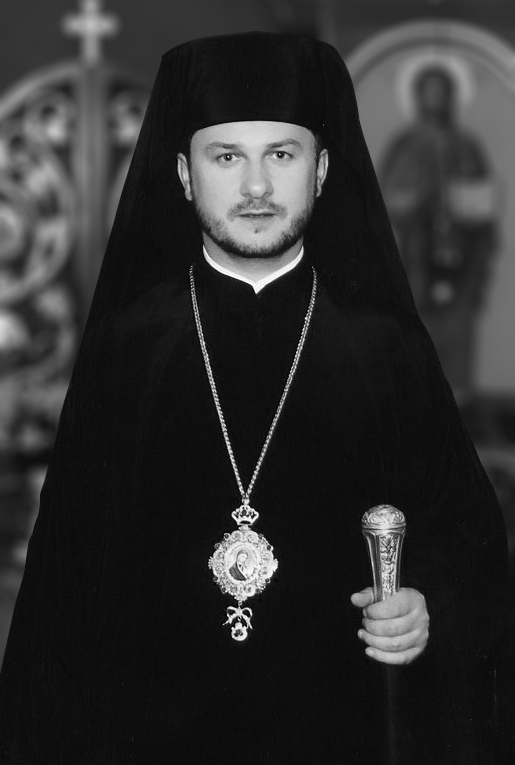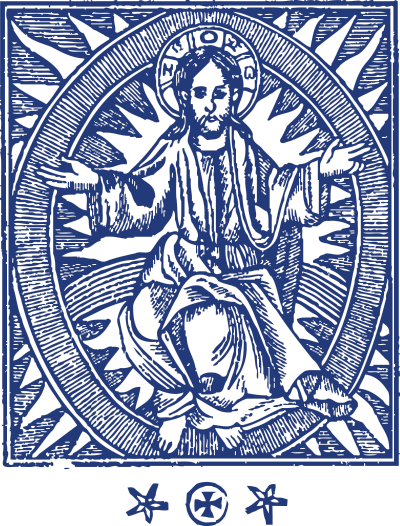 Therefore, holy brethren, partakers of the heavenly calling, consider the Apostle and High Priest of our confession, Christ Jesus, who was faithful to Him who appointed Him, as Moses also was faithful in all His house. For this One has been counted worthy of more glory than Moses, inasmuch as He who built the house has more honor than the house. For every house is built by someone, but He who built all things is God.
Therefore, holy brethren, partakers of the heavenly calling, consider the Apostle and High Priest of our confession, Christ Jesus, who was faithful to Him who appointed Him, as Moses also was faithful in all His house. For this One has been counted worthy of more glory than Moses, inasmuch as He who built the house has more honor than the house. For every house is built by someone, but He who built all things is God.
[ Hebrews 3:1-4 ]
FOUNDING OF THE EPARCHY
On the 8th of August, 1951, the Extraordinary Sobor established the Eastern Eparchy, identifying its territory and the seat of its Bishop thus:
“The Eparchy of Eastern Canada, which extends east from Sault Ste. Marie, Franz and Hearst, Ontario to the Atlantic Ocean, and whose seat is the city of Toronto…”1
As the first Bishop of the Eastern Eparchy, the Sobor elected Bishop MYKHAIL (1951-1977) with the title “Archbishop of Toronto and Eastern Canada,” and also as the Deputy Ruling Bishop.
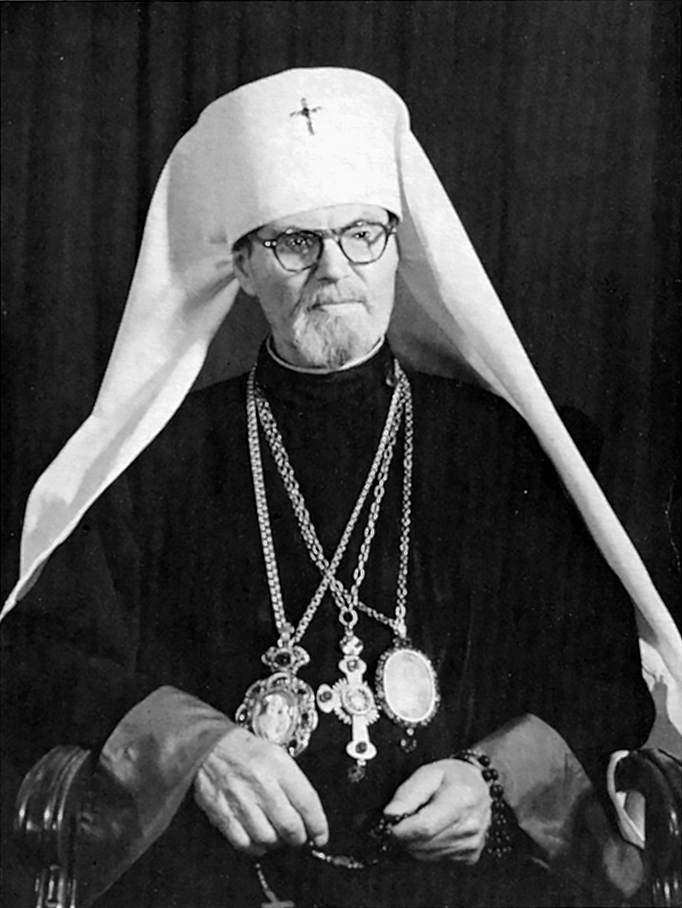
Archbishop MYKHAIL (Khoroshy)
For more than two decades previously, Ukrainian Orthodox parishes had existed in Eastern Canada — the result of the influx of Ukrainian immigrants to the region. The rise of the Ukrainian Orthodox Church is naturally tied to Ukrainian immigration to Canada, which arrived in several waves — each one of them with its own character — reflected in the order of church life. For this reason, the parishes of Eastern Canada, in their form and life, differ from the communities of the prairie provinces.
The constitution of Orthodox Church communities in Eastern Canada began following the First World War, from the year 1926, with the exception of two parishes: that of The Nativity of the Most Holy Theotokos in Oshawa, founded in 1917; and Holy Trinity in Welland, founded in 1916. Initially, both parishes belonged to the Russian Orthodox Mission in America. In 1938, the parish of The Nativity of the Theotokos joined the UGOC, while Holy Trinity transferred to the jurisdiction of Bishop Bohdan (Shpilka), in 1946.
Parishes arose thanks to the migration of Ukrainian settlers from the cold prairie provinces as well as the post-World War I immigration of those who, to a large extent, participated in the struggle for Ukrainian independence — chiefly from Bukovyna and Halychyna.
They settled in agricultural or horticultural regions like Grimsby, Waterford, Brantford; and in manufacturing and industrial centres — in Hamilton, Oshawa, Toronto, Montreal, Windsor and others.
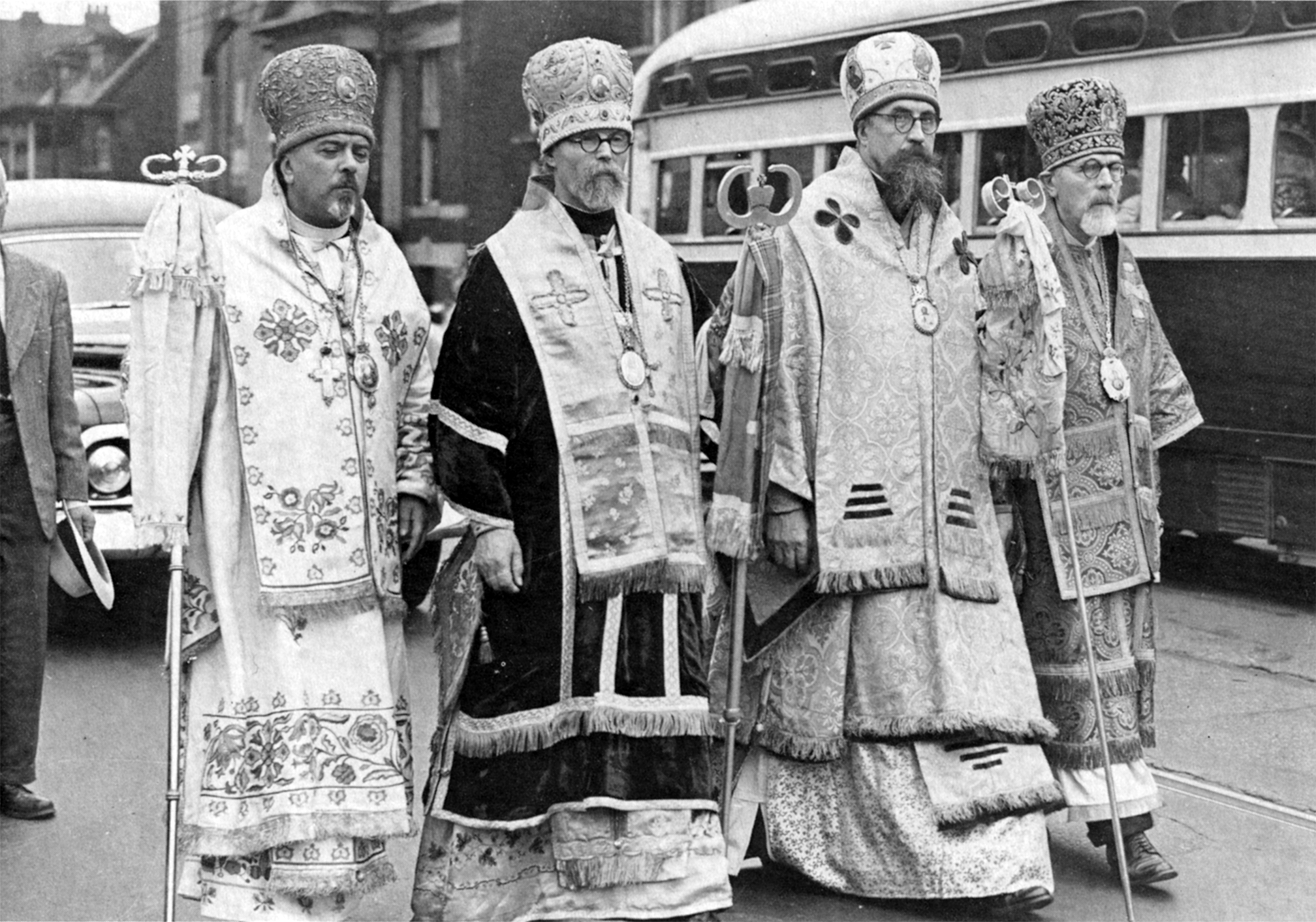
Archbishop MSTYSLAV, Archbishop MYKHAIL, Bishop HENADIY, Bishop VOLODYMYR leading the funeral procession for Bishop PLATON, August 16, 1951.
This territory was considered “missionary ground” for two Ukrainian church jurisdictions. Initially, parishes belonged to either Archbishop Ioan (Teodorovych) or Bishop Bohdan (Shpilka). The seat of both bishops was in the United States — they would come to Canada only for visitations.
The first missionaries under these jurisdictions in Eastern Canada were Fathers Volodymyr Sluzar, Petro Bilon’ and Dmytro Leshchyshyn (for Archbishop Ioan); and Fathers Andriy Sarmatiuk and Mykola Shumsky (under Bishop Bohdan). The separation of Ukrainian parishes was not merely jurisdictional; but they were also divided along “Bukovynian” and “Galician” lines.
Parish life in Archbishop Ioan’s jurisdiction was governed by the Administrator, Fr. Semen Savchuk — together with the Consistory in Winnipeg; parishes under Bishop Bohdan were overseen by the Administrator, Fr. Ivan Zazuliak. In the period leading up to and immediately after the Second World War, Bishop Bohdan’s parishes in Eastern Canada entered into the fold of the Ukrainian Greek Orthodox Church.
A new wave of immigration — predominantly Orthodox, from the eastern oblasts of Ukraine — arrived following the Second World War, settling en masse in manufacturing cities and industrial centres. Among them were a large number of Ukrainian intelligentsia — writers, university professors, doctors, priests and other professions.
The new immigration strengthened Eastern Canada’s parishes, but also introduced tensions, which fundamentally boiled down to differences in church practice. Separate parishes for the new arrivals arose; however they did not form a new church jurisdiction.
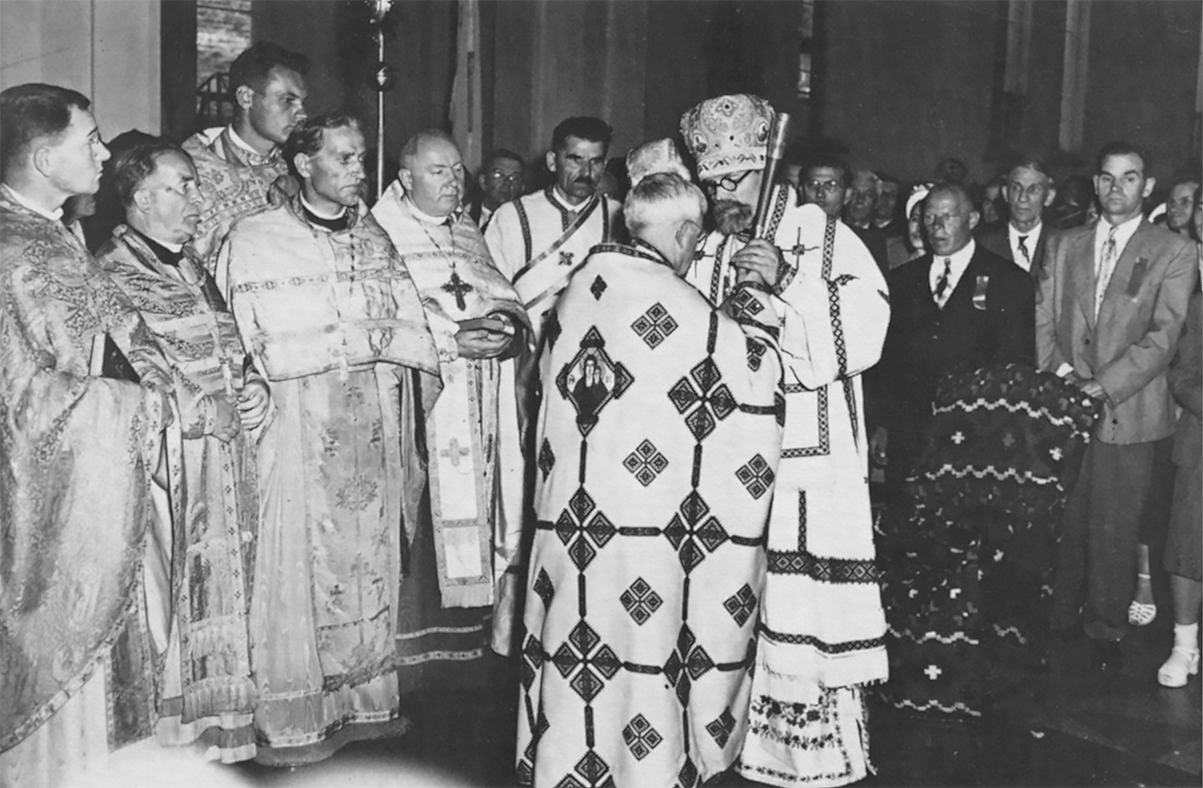
Presentation of the Bishop’s staff to Archbishop MYKHAIL in the Cathedral of St. Volodymyr, September 16, 1951
Archbishop MYKHAIL arrived in the city which was his see on the 15th of August, 1951 — a city without a Bishop’s residence, Chancellory offices, nor any sort of Eparchial administration. Everything had to be built.
A meeting in September of both priests and representatives of parishes called for an Ad hoc Advisory Council to be formed — dedicated to finding a building for the Residence and Chancellory. In order to secure the Residence’s purchase, a collection was conducted in the parishes. In February, 1952, the Eparchial Residence was inaugurated.
The first Clergy Conference and first Eparchial Assembly took place on December 7-8, 1951; Archbishop MYKHAIL’s enthronement by Metropolitan Ilarion to the Toronto kathedra — the following day, December 9th.
The Eastern Eparchy at that time consisted 21 parishes and missions. The parishes of Eastern Canada were served by 17 priests, of which 8 were from the new immigration.
The Assembly discussed the administrative structure of the Eparchy and its relationship to the Consistory. It was decided to form an Eparchial Council, choosing six delegates from among the clergy and delegates to the Assembly, in addition to the members of the Consistory from Eastern Canada (four), who acceded to the Council by virtue of their position. The permanent Head of the Council was Archbishop MYKHAIL.3 The Eparchy Council considered matters relating to the Eparchy and various local parish business.
The Eparchial Assembly and clergy meetings under the leadership of Archbishop MYKHAIL contributed to the infusion of new immigrants into existing church life.
In 1953, Archbishop MYKHAIL, informing a meeting of the Consistory about the growth of the Eastern Eparchy highlighted the fact that the number of parishioners had significantly increased, particularly in cities. In the first place was Hamilton, where the parish had swollen 60% with new arrival membership; Montreal, Toronto and other cities followed.
CONSTRUCTION OF TEMPLES AND RESIDENCES
The first decade of the Eastern Eparchy went under the banner of construction and renewal of temples and residences.
Among the information presented at the 1953 Assembly, Archbishop MYKHAIL reported that new parishes were formed in Montreal (Protection of the Most-holy Theotokos) and in Niagara Falls (Sts. Peter and Paul). New temples were built in Oshawa (Nativity of the Most-holy Theotokos), Waterford, Brantford and Niagara Falls; another already built in Lachine, Quebec. A church had been purchased in London. The parishes in New Toronto and Montreal’s Protection of the Most-holy Theotokos had purchased land on which to build their temples. The cathedral of St. Volodymyr and St. George’s parish in Grimsby had installed new ikonostasis.4
At the Assembly in 1954, it was reported that St. Vladimir’s parish in Hamilton had completed construction of a majestic temple in the Ukrainian baroque style. (Eight years later, in 1962, the ikonostas — a work of artists Ivan Vronsky and Ihor Sukhachov — would be consecrated). The Northern Ontario parish of St. Michael’s, in Kirkland Lake, purchased a church — and received a permanent priest — whose pastoral duties included caring for parishioners in Timmins.
In information given at the meeting of the Consistory in 1954, Archbishop MYKHAIL reported that the Eparchy had 22 parishes, 21 priests and 1 deacon. Ten parishes now also had residences for their priests.
Besides gains and growth, the first decade also saw its share of loss. In Preston, as a result of a legal battle, the parish of St. John lost its building, fractured, and ceased to exist. St. Michael’s parish in Freemen and Burlington also broke apart and dissolved. Through some misunderstanding, regular services were halted in Kirkland Lake.5
In this initial period of formation, particularly in small parishes, internal strife or misunderstandings often dealt a devastating blow. And, if an economic crisis in the dominant industry or manufacturing concern, with the accompanying mass exodus of workers were added to the mix, the closure of small parishes followed. This is what ultimately happened, as an example, in Kirkland Lake, once the mine shut down. St. Michael’s parish persevered for a while, but in the end, closed its doors permanently in 1977.
In contrast to those communities that ceased to exist as a result of population outflow, the influx of new immigrants created new congregations. In great measure, this depended on the missionary and organizational talents of the priests.
1956 saw the formation of the parish of The Protection of the Most Holy Theotokos in Leamington and St. John’s parish in Chatham. At the same time, the community in Kitchener, which had witnessed decline, realized a revival with the appointment of Fr. Yurij Tsukornyk, and members of the former Preston parish joined them.6
In 1958, St. Anne’s parish was organized in Scarborough, in Toronto’s east. The number of parishioners grew across parishes in Toronto, Montreal, Hamilton and Windsor. The parish of St. Demetrius in New Toronto expanded, and moved into the newly-built Ukrainian baroque-style church in Long Branch, in the west end of the city. Two years later, the ikonostas, built by I. Vronsky, with icons written by I. Sukhachov was installed and consecrated. St. Volodymyr’s parish in Sudbury erected a new temple in the Ukrainian style.
At the 12th Sobor, in 1960, Archbishop MYKHAIL reported that the Eastern Eparchy had 26 parishes and 24 priests. From the time of the founding of the Eparchy, nine years earlier, Eastern Canada had seen the construction or purchase of 12 churches, while 5 temples were in the process of being built. In other words, the period of construction of temples and residences continued, unabated.
1961 witnessed the construction of a new temple, Protection of the Most Holy Theotokos, in Montreal — and St. George’s in St. Catharines. 1962 saw the construction of a new temple in the Byzantine style — St. Sophie — in Montreal. The same year witnessed the building of temples dedicated to St. Anne in Scarborough, and St. Andrew in Toronto’s west end.
In 1963, the community in Windsor built a new church — St. Vladimir’s. The following year, a temple dedicated to the Assumption (Dormition) of the Blessed Virgin was consecrated in Ottawa. In 1970, St. Sophia’s parish purchased an existing property in Waterloo — and moved there. With the construction of the temple dedicated to the Protection of the Most Holy Theotokos in Sault St. Marie, the initial period of construction in the Eastern Eparchy came to an end — with one exception — in 1973, came the first attempt to organize a parish dedicated to Archangel Michael.
Most of the Eparchy’s temples were built according to plans drawn up by — and under the oversight of — architects Yuri Kodak and Gregory Khorosh.
If the development of faith-based communities depended a great deal on the organizational talent of priests — even more of this talent was required when it came to the purchase, and especially construction, of that community’s temple. All of the Ukrainian Orthodox temples which are the pride of the Eastern Eparchy were built by the monumental work of the priests and parish councils who could motivate their parishes, and who were especially effective at gathering funding for building, equipping and adorning these sacred places of worship.
In 1961, the Eparchy was divided into 4 Missionary Districts:
- The Toronto Mission District included the parishes in: Toronto, Oshawa, Sudbury, Sault Ste. Marie
- The Hamilton Mission District included parishes in: Hamilton, St. Catharines, Grimsby, Niagara Falls, Welland, Waterford, Brantford, Kitchener and London (which later became part of the Windsor Mission District)
- The Montreal Mission District included parishes in: Montreal, Lachine and Ottawa.
- The Windsor Mission District included parished in: Windsor, London, Sarnia, Chatham and Leamington
The Eparchy’s second decade passed focused on filling the newly-built churches and premises with the life of the Church.
The energies of the clergy and parish councils (mobilized during the period of community formation, purchase of properties and construction of new temples) turned now to their internal governance, Ukrainian parish school programs, the education of youth and the development of church and community life. This increasingly led to internal friction and competition between “new” and “old” immigrants.
Differing points of view regarding the character of the development of Ukrainian church life in Canada came to the fore. The competition travelled from the parishes to Consistory meetings7 and into meetings of the Eparchy Council. Now, the activity of the Council took on more significance in the resolution of problems in Eparchy parishes. Ultimately, time resolved the differences that existed between individuals, who grew accustomed to new circumstances.
EDUCATION OF CHILDREN AND YOUTH
One of the driving principles of Ukrainian Orthodox communities was the desire of these communities to safeguard proper religious and Ukrainian education for their children and grandchildren. From the outset, every organized community turned its attention to children’s education and to the teaching of the Ukrainian language. Virtually every parish hosted a Ridna Shkola — a school where the language of instruction was Ukrainian, and the subjects taught included aspects of Orthodox faith, Ukrainian history and culture.
According to information provided to the Consistory by Archbishop MYKHAIL at a meeting in 1954, 345 children were studying in parish schools in Toronto; 80 in Windsor; 75 in Hamilton and nearly 100 in Montreal.
In 1957, he drew attention to the fact that membership in the parishes had significantly increased, especially in the larger cities. Schools had correspondingly grown in number of children and teachers in the Toronto, Montreal, Hamilton and Windsor parishes. This necessitated improvement in facilities and even the construction of new buildings to house the schools. The Toronto cathedral parish school alone was teaching more than 450 children. This was the new task Archbishop MYKHAIL set for the Eastern Eparchy.
A Teachers’ Conference was held concurrently with the Eparchy Assembly in 1961, under the banner “Youth Education and Schools”. The matter of schooling in the Eparchy gained greater attention. Included in the Assembly program was a report by Prof. Vasyl Ivanys on school matters. The Head of the Council of Ukrainian Schools described the work of Ukrainian schools in the parishes.
A program of instruction was produced and approved. That year, Eparchy parish schools registered 1,237 students, who were taught by 97 teachers. An important development was that parish delegates discussed the matter of educating children as an essential aspect of parish and church life.
The Assembly determined that, henceforth, the Head of the Council of Ukrainian Schools would automatically become a member of the Eparchy Council. Every year after that, annual parish reports to the Assembly always included descriptions of the state of Ukrainian and Sunday schools and youth education.
In larger cities, following the completion of Ukrainian school elementary classes, students would continue in courses of Ukrainian Studies, the program of which was comparable to highschool. In Hamilton, in 1966, a separate school building was built, with corresponding classroom facilities.
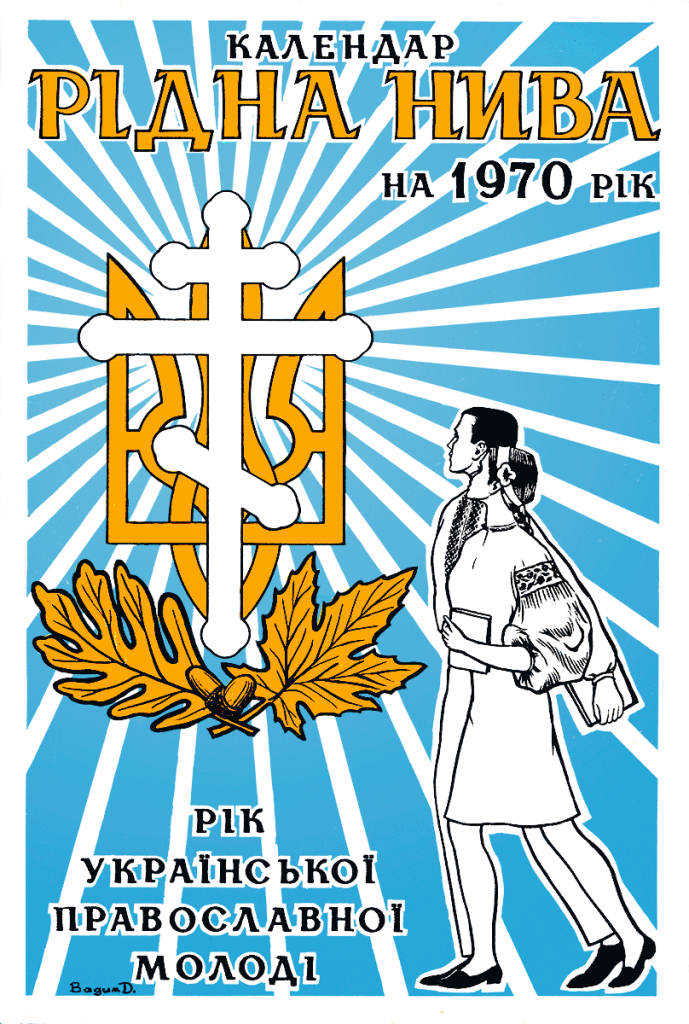
PARISH ORGANIZATIONS
In every parish during the time of the development of the UGOC in Eastern Canada, there arose community organizations. Toward the end of the 1920s, the Ukrainian Self-Reliance League was formed to further the Church’s interests.
The League comprised three component organizations: The Ukrainian Women’s Association of Canada (СУК), The Ukrainian Self-Reliance Association (ТУС), (for Orthodox men) and Ukrainian Orthodox Youth of Canada (СУМК). These three were active in almost every community. Integral and particularly important for every parish were the branches of the Women’s Association. The work of the women was directed by Branch councils, and included cultural and educational matters — and the assignment of responsibilities for care and upkeep of the church. Each priest saw to it that the youth of his parish were knit into the older or younger wings of СУМК.
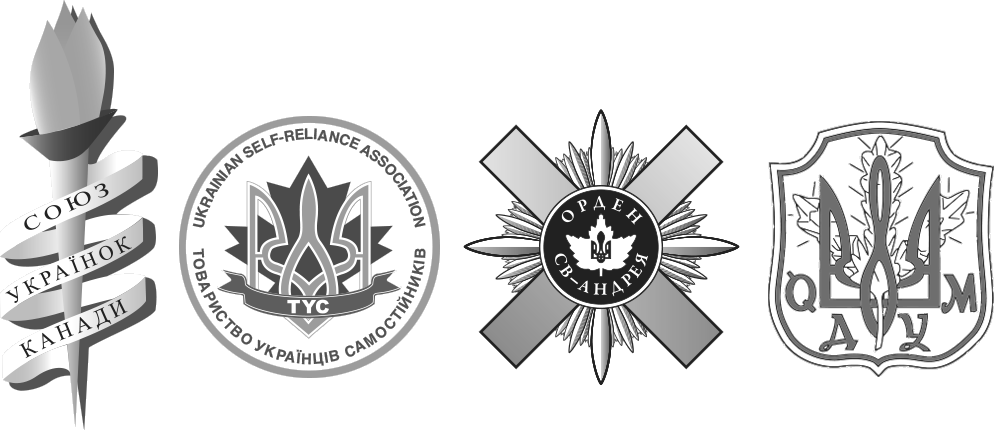
Following the Second World War, in the period of the founding of the Eastern Eparchy, things changed. With the arrival of new immigrants, new organizations appeared, either borne with the new arrivals from their experiences in post-war Europe — or created by them in Canada. In many communities, friction accompanied the introduction of new organizations. In those where the recent arrivals were in the minority, there — the already-existing societies remained. In parishes organized exclusively by the new immigrants themselves, there arose their own, new organizations. In those parishes, the women’s organizations became sisterhoods.
In the larger cities (Toronto, Montreal and others) both one and the other organizations existed in parallel, a situation which continues to some extent today. Brotherhoods were formed in the parishes, the most prominent of which was the Brotherhood of St. Volodymyr at the Cathedral in Toronto, engaged in cultural and educational work and the publication of religious materials. In 1974, the Cathedral of St. Volodymyr housed 14 different organizations — all in competition with each other for influence in the the community. The most painful was the competition between the youth organizations СУМК and ОДУМ (Union of Democratic Ukrainian Youth). That year (1974), there were 92 members of СУМК and 135 members of ОДУМ. During that summer at Camp “Kyiv”, the children’s camp sponsored by the Cathedral community hosted 65 children; that organized by СУМК — more than 60; that run by ОДУМ — over 200.8
DEVELOPMENT FOLLOWING INITIAL ACHIEVEMENTS
The first two decades of intense work of priests, parish councils and membership of the Eastern Eparchy had won great achievements in the construction and adornment of temples and the development of church life.
In 1929, the Ukrainian Greek Orthodox Church of Canada received its Charter. This enabled the registration of Ukrainian Orthodox parishes to be carried out, not by provincial governments, but by the Consistory in Winnipeg. All the parishes of Eastern Canada were registered with the Consistory from 1932-1999. The first to be registered was St. Volodymyr’s parish in Toronto, on March 18, 1932; the last was St. George’s parish in Lachine on February 28, 1999. After the establishment of the Eparchy, 14 parishes were accepted into the fold of the UGOCC.9
By 1974, after 20 years of existence, the Eparchy had achieved 26 parishes and 26 priests. 3,212 parishioners were registered. 15 parishes held Sunday Schools where 454 students were taught by 57 teachers. 16 parishes had active Ukrainian Schools, with 596 students enrolled; 10 parishes offered Ukrainian Studies courses with 181 registrants. 86 teachers taught in these schools and courses.
Virtually every parish benefited from the work of a women’s organization — in 18 parishes, there were 863 active members of the Ukrainian Women’s Association of Canada; in 6 other parishes there were 173 members of sisterhoods. In 9 parishes, both the older and younger wings of the Ukrainian Orthodox Youth of Canada had 337 members. In 5 parishes where ОДУМ was active, it had 231 members.
The value of church (temple) real estate in the Eparchy was assessed at $4,616,000; and the value of all real estate was estimated at $7,088,000. Movable property in temples, halls and residence stood at $770,065.10
At the meeting of the Consistory before the 1975 Sobor, Archbishop (now, Metropolitan) MYKHAIL gave notice of his wish to remain on the Toronto cathedral as “Metropolitan Emeritus — Archbishop of Toronto and the Eastern Eparchy.” Because of the Metropolitan’s failing health, Bishop MYKOLAI (Debryn), Bishop of Saskatoon, was appointed as his assistant. The Chatham parish installed a new ikonostasis, consecrated by Bishop MYKOLAI, already acting in this capacity.
Metropolitan MYKHAIL fell asleep in the Lord in 1977. Bishop MYKOLAI (1978-1981) was elected to the Toronto kathedra with the title: “Bishop of Toronto and the Eastern Eparchy.”
Bishop MYKOLAI was born in 1903 in Bukovyna. He studied at the University in Iasi, Romania, where he earned a diploma in engineering. During the war, he emigrated to the West, coming to Canada in 1949.
Completing his studies at the Faculty of Theology at St. Andrew’s College in 1959, he was ordained a priest — and, in 1975, consecrated Bishop with the title of “Bishop of Saskatoon.” in 1980, he was elevated to Archbishop.
At the 28th Eparchial Assembly, the matter of purchasing a Bishop’s Residence was raised. The previous Residence had already been sold — and the acquisition of a new property was also discussed at the subsequent Assembly.
Archbishop MYKOLAI fell asleep in the Lord in 1981. Bishop WASYLY, the Bishop of Saskatoon, was named the Acting Bishop of the Eastern Eparchy (1981-1985). Because he was also the coadjutor of Metropolitan ANDRIY, his residence was in Winnipeg. In 1984, he received the title “Archbishop of Toronto and the Eastern Eparchy.”
Bishop WASYLY (Fedak) was born in 1909 in Bukovyna, coming to Canada with his parents in 1912. In 1944, he was ordained a priest. For 28 years, he was the rector at the parish of St. Vladimir in Hamilton — and was consecrated Bishop of Saskatoon in 1978. in 1985, he was chosen Metropolitan. Because no new bishops had been consecrated in Canada, the Toronto kathedra remained vacant, and the Eastern Eparchy was overseen by Metropolitan WASYLY until 1992.
The Synod of Bishops of the UOCC appointed Bishop YURIJ, the Bishop of Saskatoon, as the Acting Bishop of the Eastern Eparchy in 1991.
Bishop YURIJ (Kalistchuk) was born in 1951 in Lachine, Quebec, to a family of new immigrants. (The Kalistchuk family would later move to Hamilton, Ontario). in 1973, he finished his studies at the Faculty of Theology at St. Andrew’s College, and in 1984, at the University of Toronto. In 1988, he was ordained a priest, and in 1989 was consecrated Vicar Bishop of Saskatoon. At the March 29-30, 1992 meeting of the Consistory, following his appointment to Eastern Canada, he said “We will study the unique features of life in this Eparchy. A whole series of visitations to the majority of these communities are intended, which will give an opportunity to become more familiar with the life of individual parishes.” The absence of a resident Bishop had given way to the growth of alienation and led to decline, particularly in smaller parishes. The older priests, too, had entered retirement or fallen asleep in the Lord — and it was difficult to replace them.
At a meeting of the Consistory in 1993, Bishop YURIJ reported that recovery in the Eparchy could be seen. That year, the Eparchy had 26 parishes, with 2,601 members — but of those, only 11 had submitted information about their current state. Of those 11, all had Sunday schools, with 119 students — and 5 parishes had Ukrainian School with 231 students enrolled. In the youth organizations (of reporting parishes): СУМК — 103 members; ОДУМ — 22. In 16 Branches of the Ukrainian Women’s Association, there were 716 members. 17 parishes of 26 fulfilled their financial obligations to Eparchy Council funds.11 Also in 1993, a Residence was purchased for the Bishop and a Chancellory organized. For the residence, a collection was taken up in the Eastern Eparchy’s parishes. The Church Sobor of 1995 granted Bishop YURIJ the title “Bishop of Toronto and the Eastern Eparchy.”
At the March 1-2, 1998 meeting of the Consistory, Bishop YURIJ reported on the arrival of new immigrants from Ukraine, who were becoming parish members. The influx of new immigrants strengthened parishes in Hamilton, Montreal and London. In 1999, the parish of Archangel Michael in Bradford, renewed its existence.
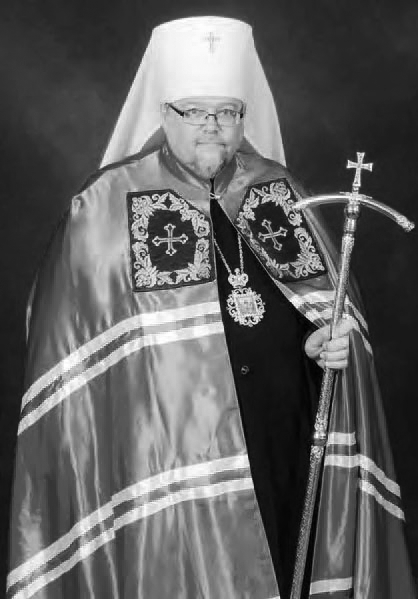
Metropolitan YURIJ (Kalistchuk)
On July 18, 2010, at the 22nd Sobor of the Ukrainian Orthodox Church of Canada, Archbishop YURIJ was elected the sixth Metropolitan of the Ukrainian Orthodox Church of Canada.
On the 30th of August, the Holy and Sacred Synod of the Ecumenical Patriarchate of Constantinople ratified the Sobor’s decision and elevated His Eminence to the Metropolitan’s Throne of the UOCC with the title “Archbishop of Winnipeg and the Central Eparchy, Metropolitan of Canada.”
In February, 2011, His Grace, Bishop ANDRIY (Peshko), who had been appointed “Bishop of Saskatoon and Vicar Bishop of the Central Eparchy” by the 2008 Extraordinary Sobor of the Ukrainian Orthodox Church of Canada — assumed the responsibilities of the Diocesan Bishop of the Eastern Eparchy.
- Протокол Надзвичайного Собору УТПЦ. Вінніпег. 1951—С.35.↩
- Катедральна парафія Св. Володимира (організована в 1926) в Торонті; Св Димитрія (1940) в Нью-Торонті; Св. Андрія (1951) Західному Торонті; Св. Софії (1926) в Монреалі; Св. Юрія (1945) в Лашін; Успіння Пресвятої Богородиці (1949) в Оттаві; Св.Івана (1935) в Ошаві; Різдва Пресвятої Богородиці (1916) в Ошаві; Св. Володимира (1926) в Гамільтоні; Св.Покрови (1927) у Ватерфорді; Св. Володимира (1927) у Віндзорі; Св. Івана у Престон; Св.Михаїла (1948) в Киркленд Лейк; Св. Юрія в Ст. Кетеринс; Св. Володимира (1948) в Садбурі; Пресвятої Тройці (1950) в Лондоні; Св. Михаїла в Брентфорді; Св. Юрія (1943) в Гримсбі; Пресвятої Тройці в Сарнії; Пресвятої Тройці (1917) в Велланд; Св. Михаїла в Фрімен.↩
- Протокол Першого Єпархіяльного З’їзду. Торонто. 8 грудня 1951 р. Копія//Архів Т.М.↩
- Протокол 3-го З’їзду Східної Єпархії. 5 грудня 1953 р. Копія //Архів Т.М.↩
- Протокол нарад Повної Консисторії. 27-29 грудня 1955 р.— С.4//Архів УПЦК, фонд Консисторії, Протоколи.↩
- Протокол нарад Повної Консисторії. 25-27 грудня 1956 р.— С.4//Архів УПЦК, фонд Консисторії, Протоколи.↩
- Протокол нарад Консисторії. 10-12 грудня 1965 р.—С. 12-18//Архів УПЦК, фонд Консисторії. Протоколи↩
- Протокол 23-го Єпархіального З’їзду. 29-30 листопада 1974 р. Копія//Архів Т.М.↩
- Реєстрація парафій.//Архів УПЦК, фонд Консисторії.↩
- Протокол 23-го Єпархіального З’їзду. 29-30 листопада 1974 р. Звіт Секретаря Єпархіальної Ради о. Тимофія Міненка “Стан Східної Єпархії.”//Архів Т.М.↩
- Протокол 23-го Єпархіального З’їзду. 29-30 листопада 1974 р. Копія//Архів Т.М.↩

